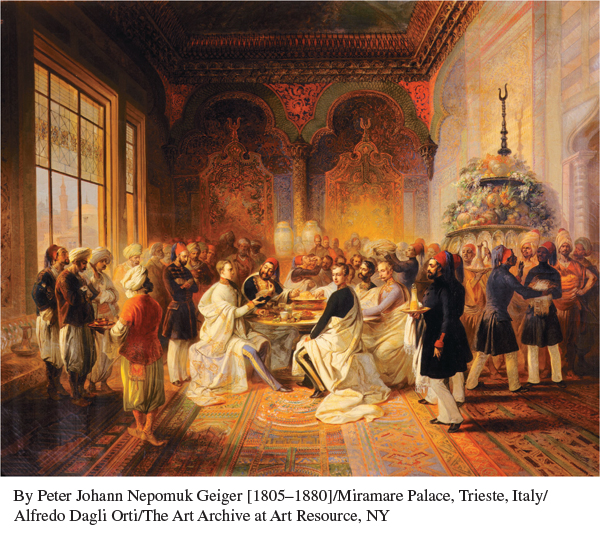A History of Western Society: Printed Page 772
A History of Western Society, Value Edition: Printed Page 739
A History of Western Society, Concise Edition: Printed Page 769
Chapter Chronology
Reform and Readjustment in the Ottoman Empire
Page 772
By the early nineteenth century the economic and political changes reshaping Europe were also at play in the Ottoman Empire, which stretched around the northeastern, eastern, and southern shores of the Mediterranean Sea. The borderlands of this vast empire experienced constant flux and conflict. Russia had occupied Ottoman provinces on the Danube River in the last decades of the eighteenth century and grabbed more during the Napoleonic Wars. In 1816 the Ottomans were forced to grant Serbia local autonomy. In 1830 the Greeks won independence, and French armies began their long and bloody takeover of Ottoman Algeria. Yet the Ottomans achieved important victories during the same decades. Egyptian forces under the leadership of Muhammad Ali, the Ottoman governor in Egypt, restored order in the Islamic holy lands and conquered significant portions of Sudan, south of Egypt.
Muhammad Ali, a ruthless and intelligent soldier-politician, ruled Egypt in the name of the Ottoman sultan from 1805 to 1848. His modernizing reforms of agriculture, industry, and the military (see Chapter 24) helped turn Egypt into the most powerful state in the eastern Mediterranean. In time, his growing strength directly challenged the Ottoman sultan and Istanbul’s ruling elite. From 1831 to 1840 Egyptian troops under the leadership of Muhammad Ali’s son Ibrahim occupied and governed the Ottoman province of Syria and Palestine, and threatened to depose the Ottoman sultan Mahmud II (r. 1808–1839).
This conflict forced the Ottomans to seek European support. Mahmud II’s dynasty survived, but only because the European powers, led by Britain, allied with the Ottomans to discipline Muhammad Ali. The European powers preferred a weak and dependent Ottoman Empire to a strong, economically independent state under a dynamic leader such as Muhammad Ali.
Faced with growing European military and economic competition, liberal Ottoman statesmen in 1839 launched an era of radical reforms known as the Tanzimat, or “Reorganization.” The Tanzimat reforms, borrowed from western European models, were designed to modernize the empire. The high point of reform came when the new liberal-minded sultan, Abdul Mejid (r. 1839–1861), issued the Imperial Rescript of 1856, just after the Crimean War. Articles in the decree called for equality before the law regardless of religious faith, a modernized administration and army, and private ownership of land. As part of the reform policy, and under economic pressure from the European powers that had paid for the empire’s war against Russia in Crimea, Ottoman leaders adopted free-trade policies. New commercial laws removed tariffs on foreign imports and permitted foreign merchants to operate freely throughout the empire.

Pasha Hilim Receiving Archduke Maximilian of Austria As this painting suggests, Ottoman leaders became well versed in European languages and culture. They also mastered the game of power politics, playing one European state against another to secure the Ottoman Empire’s survival.
(By Peter Johann Nepomuk Geiger [1805–1880]/Miramare Palace, Trieste, Italy/Alfredo Dagli Orti/The Art Archive at Art Resource, NY)
The turn to nineteenth-century liberal capitalism had mixed effects. On one hand, with the growth of Western-style banking and insurance systems, elite Christian and Jewish businessmen in the empire prospered. Yet the bulk of the profits went to foreign investors rather than Ottoman subjects. More important, the elimination of traditional state-controlled monopolies sharply cut imperial revenues. In 1851 Sultan Mejid was forced to borrow 55 million francs from British and French bankers to cover state deficits. Other loans followed, and intractable indebtedness led to the bankruptcy of the Ottoman state two decades later.
Intended to bring revolutionary modernization, the Tanzimat permitted partial recovery but fell short of its goals. The Ottoman initiatives did not curtail the appetite of Western imperialists, who secured a stranglehold on the imperial economy via issuing loans. The reforms also failed to halt the growth of nationalism among some Christian subjects in the Balkans, which resulted in crises and increased pressure from neighboring Austria and Russia, eager to gain access to the Balkans and the eastern Mediterranean.
Finally, equality before the law for all citizens, regardless of religious affiliation, actually increased religious disputes, which were often encouraged and manipulated by the European powers eager to seize any pretext for intervention. This development embittered relations between religious conservatives and social liberals, a struggle that ultimately distracted the government from its reform mission. Religious conservatives in both the Muslim and Greek Orthodox communities detested the religious reforms, which they viewed as an impious departure from tradition. These conservatives became dependable supporters of Sultan Abdülhamid II (ahb-dool-hah-MEED) (r. 1876–1909), who in 1876 halted the reform movement and turned away from European liberalism in his long and repressive reign.
Abdülhamid II’s government failed to halt foreign efforts to fragment and ultimately take control over key Ottoman territories. Defeat in the Russo-Turkish War (1877–1878) meant the loss to Russia of Ottoman districts in the Caucasus; formal declarations of independence for Romania, Montenegro, and Serbia, all former Ottoman territories in the Balkans; and the establishment of an autonomous Bulgaria, still nominally under the Ottoman sultan’s control. By the 1890s the government’s failures had encouraged a powerful resurgence of the modernizing impulse under the banner of the Committee of Union and Progress (CUP), an umbrella organization that united multiethnic reformist groups from across the empire. These fervent patriots, unofficially called the Young Turks, seized power in a 1908 coup and forced the sultan to implement new reforms. Although they failed to stop the rising tide of anti-Ottoman nationalism in the Balkans, the Young Turks helped prepare the way for the rise of modern secular Turkey after the defeat and collapse of the Ottoman Empire in World War I.
Page 773
